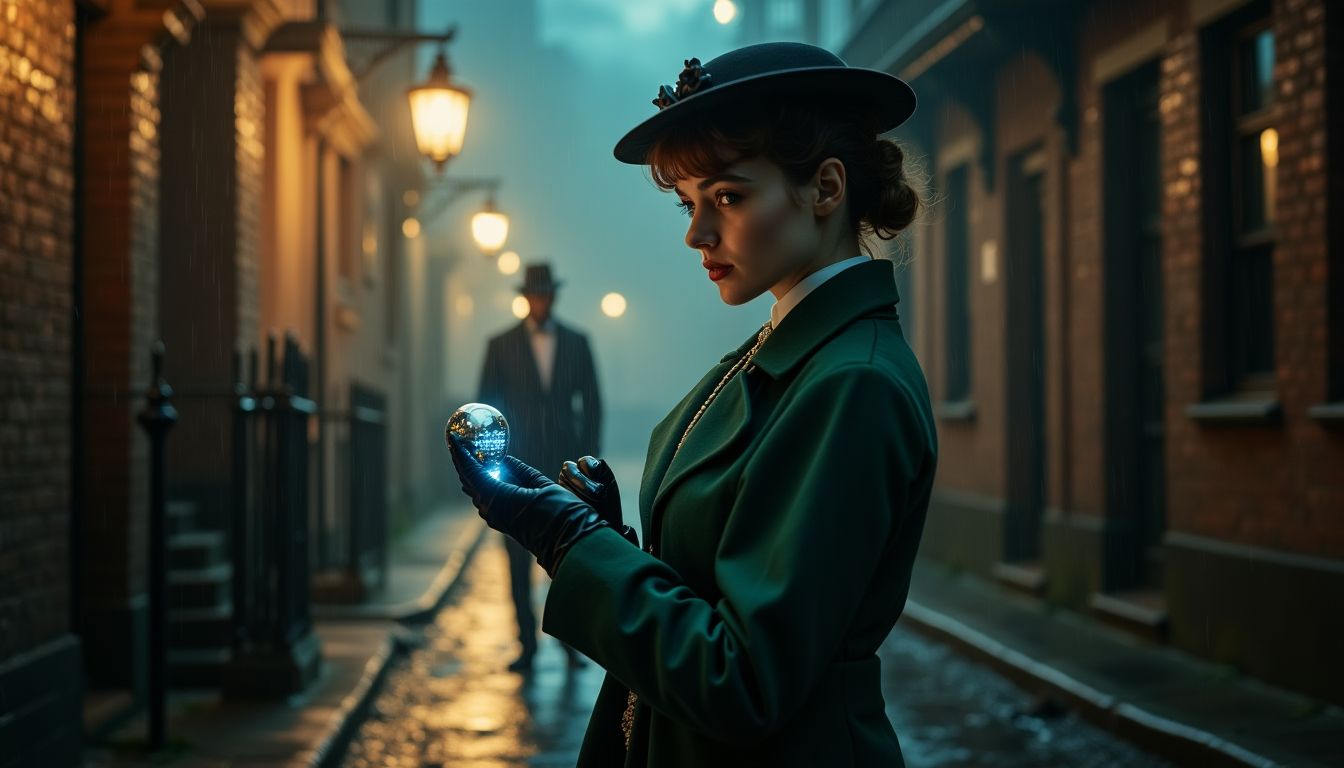Rain hammered the cobbled streets of London in the year 1899, the twilight of the 19th century. Gas lamps flickered weakly in the misty haze, casting dim, golden halos over the sprawling cityscape. Rosalind Ashcroft stood on a corner, unnoticed by the throngs of hurried pedestrians. She clutched her umbrella tightly against the biting wind, her emerald-green cloak swirling about her ankles. Beneath it, a corset cinched her slender midsection, and her bustle skirt curved gracefully over her hips. Her chestnut-brown hair coiled neatly into a chignon beneath the modest bonnet she wore. She looked every bit the proper Victorian woman—except for the device she cradled in her other hand.
The object was sleek and alien, made of smooth, burnished metal that shimmered faintly in the dim light. It pulsed with an eerie, faint blue light, and its intricate network of dials and levers seemed to possess a life of their own. To those who might glance too closely, it appeared more like the innovation of one of Jules Verne’s fever dreams than a tool from Rosalind’s own era. She called the device "The Arcadian Splicer." To her, it was both a blessing and a curse.
A figure emerged from the shadows across the street. He wore a dark trench coat and carried a bowler hat in one hand. As the man approached, Rosalind’s grip on the Arcadian Splicer tightened. "Mister Keene," she addressed him curtly, her voice clipped and formal, though her heart raced beneath her bodice.
Keene, a wiry man in his early 40s with a grizzled face and piercing hazel eyes, nodded but did not smile. "Miss Ashcroft," he replied. "You have it, then?" His gaze flicked toward the device in her hands.
"I do," she said, her voice steady despite the tension in the air. "And you swear to me that this will put an end to the disruption?"
Keene's jaw tightened. "It will. But you must trust me. We don’t have much time."
Rosalind hesitated, her gloved fingers twitching on the Splicer. She had constructed the device using sketches left by her late mentor, Professor Alderidge, a forward-thinking physicist who had believed in the possibility of manipulating energy fields to stabilize the increasingly erratic behavior of the city’s new power grid. The grid, fed by coal-fueled steam dynamos, had been experiencing unexplained surges and outages—phenomena far too advanced for the scientific understanding of the time. But Rosalind knew the truth.
The disruptions were not caused by coal, nor by faulty dynamos, but by time itself.
One year earlier, during the great blackout of 1898, Rosalind had stumbled upon an anachronistic device deep within the bowels of London’s first power station. A metallurgical impossibility for her time, the strange machine emitted the same eerie blue light that now pulsed through her Splicer. She had taken it to Professor Alderidge, who confirmed her suspicions: the artifact was not of their time. It had been sent backward, out of sequence, by forces beyond their understanding. And it was fracturing the very fabric of time in the process.
For a year, Rosalind had worked to construct a countermeasure. She had risked everything—her reputation, her health, her freedom—to decode blueprints that seemed to shift and evolve with each passing week. And yet, the fractures had only worsened. Time stuttered. People reported seeing phantoms of themselves on streets they had walked moments before. The flow of electricity had become erratic, driving parts of the city into chaos. And the weather… storms that didn’t belong to England’s placid late summers had ravaged the countryside.
"What if you’re wrong?" she asked Keene now, her voice trembling ever so slightly.
The man shook his head grimly. "I’m not wrong. If we don’t recalibrate the Splicer at the exact moment of the next surge, London will tear itself apart. The temporal rift will grow until it consumes us all."
The Clock Strikes Nine
A bell tolled in the distance—Big Ben, sonorous and inexorable. It was nine o’clock. The surge would come in two minutes, precisely as Keene had predicted. Rosalind nodded and handed him the Splicer. "It must be set to 743 megahertz," she instructed, pointing to the device’s largest dial. "If you deviate even slightly—"
"I know," he interrupted. "Trust me."
They entered the power station in silence, their boots clattering against the iron-grate floors. The air was thick with the smell of oil and steam. Enormous turbines, powered by coal and water, thrummed with a deafening roar. At the heart of the room stood a glowing sphere—a time anomaly manifest. It pulsed erratically, casting shifting afterimages against the walls. Keene approached it, the Splicer cradled gingerly in his hands.
Rosalind stayed back, her fists clenched tightly. She watched as Keene calibrated the device with deft precision, each movement of his fingers like the unfurling of clockwork. Finally, he connected the Splicer to two protruding conduits near the sphere. A low hum filled the air.
The glow intensified, shifting from blue to white. Rosalind shielded her eyes as the hum crescendoed into an earsplitting whine. For a moment, the entire station seemed frozen in place, locked in a single breathless instant.
Resolution… Or Betrayal?
When the light finally dimmed, Rosalind opened her eyes. The sphere was gone. The air felt still, almost preternaturally so. She exhaled in relief—but Keene’s expression gave her pause.
"It’s done," he said, handing her the Splicer. His voice was calm, too calm.
But before she could speak, she noticed something was amiss. The dials on the Splicer had been altered—not set to her instructions. "What did you do?" she demanded.
Keene turned to walk away. "What I had to."
"Keene!" she shouted, but he was already vanishing into the shadows of the station.
Rosalind stared at the Splicer in her hands, dread pooling in her stomach. The sphere was gone, yes—but how much of London’s timeline had he changed in the process? And to what end?
A New Timeline
When she emerged from the power station into the rain-drenched streets, something was different. The skyline was wrong—new buildings she didn’t recognize stretched upward into the haze. Electric-powered carriages glided silently where horses should have trotted. People strode past her, dressed in garments that blended the Victorian and the futuristic. Somewhere, the chime of a telephone—no, something beyond a telephone—pierced the air.
Rosalind's heart sank as she realized the truth. Time hadn’t been repaired. It had been rewritten.
And she didn’t belong here anymore.
Genre: Alternate History/Science Adventure
The Source...check out the great article that inspired this amazing short story: Why Does the US Experience So Many Frequent Power Outages?
Disclaimer: This article may contain affiliate links. If you click on these links and make a purchase, we may receive a commission at no additional cost to you. Our recommendations and reviews are always independent and objective, aiming to provide you with the best information and resources.
Get Exclusive Stories, Photos, Art & Offers - Subscribe Today!

























Post Comment
You must be logged in to post a comment.